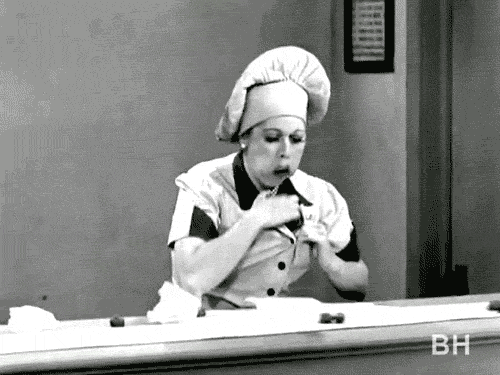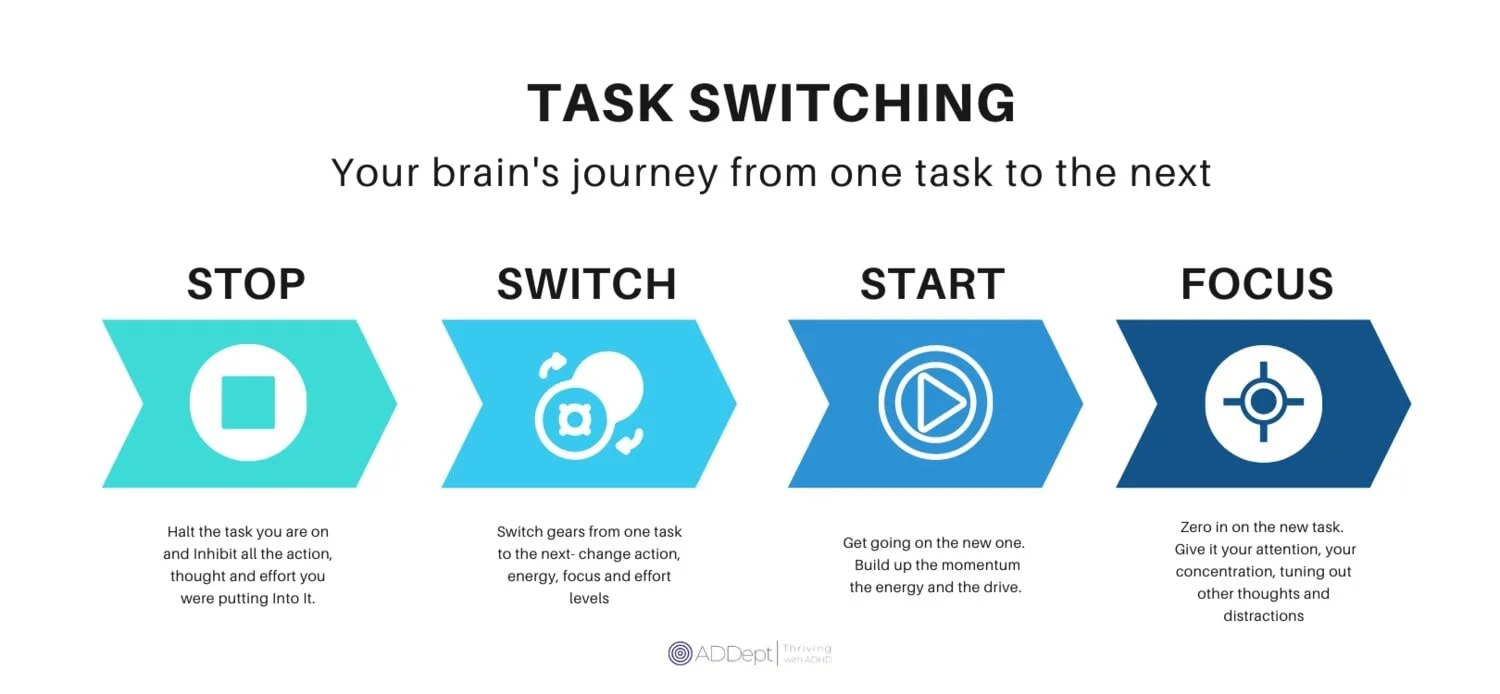Why is Task Switching with ADHD
so Hard?
You know the feeling. You’re scrolling, scrolling, scrolling, your thumb keeps swiping up, and your eyes have started to glaze over, there is a voice in your head that is telling you to "put the stupid phone down!" but you keep on scrolling?
Or how about those times when you are so absorbed in your work- maybe you are investigating your newest obsession or tinkering with some new hobby or reading about your most recent passion- and someone walks into the room and starts talking, and you barely hear them? Or maybe you do hear them, but rather than registering that you should listen, you feel the rage of being interrupted boiling inside?
That’s your brain putting up a fit. A full-on toddler-didn’t-get-his-blue-cup-tantrum. Your brain is telling you no- I will NOT stop this activity. I refuse to stop and move on. I Must. Keep. Going.
Why is it so hard to switch away from one thing and onto the next? Let's dive in and find out.
Think you might have ADHD?
Take a free online assessment to find out.
(Takes 3 minutes)
TAKE THE QUIZ
What is task switching?
Task switching is the technical term when your brain stops focusing and acting on one thing and switches over to do another. But not all tasks require switching. We can drive and talk at the same time. We can walk and listen while we eat lunch, listen to music, and read a book all at the same time. The important thing to note, though, is that our brains CAN'T do more than one complicated, complex, or novel task at a time— or at least not well and quickly.
If one of those tasks is automatic- think eating, breathing, walking, or doing dishes) we're good. But as soon as the task gets more complex, our brains are like lucy desperately trying to eat all the chocolates on a conveyor belt at warp speed- sure, she got a mouthful, but soon she has to come up with another solution!
Task Switching Psychology
Before we get into the neurology and psychology of task switching, let’s review what we know about executive functions:
Our brains are like an orchestra. We have individual musicians with varying talents and skills, and then we have a conductor who tells all those musicians when, how, in what order, and how much to play. The conductor tells the musicians when to start, stop, get louder, get stronger, speed up, and slow down. The conductor keeps the pace, it directs the members, and it keeps the vision for what the overall piece is meant to sound like.
That conductor? That’s your brain’s executive functioning system.
So, now, back to task switching…
Every time you switch tasks, your brain makes that conductor do 4 different tasks (executive functions):
Stop/ Inhibit (pulling yourself away)
Switch (moving over to the next task)
Start (getting going on the new task)
Focus (zeroing in on that new task)
We’re all granted a limited about of executive functioning resources for our day. It’s as if your executive functioning system (your conductor) was given a handful of cash at the beginning of the day. But every time he gave a command (use an executive function) he had to pay a dollar. So task switching means that conductor has to pay $4 rather than it’s usual $1. That’s a major price increase!
And let's not forget that the executive functions of task switching are just a few of the long list of executive functions our conductor has to use throughout our day. So when we spend a lot of those resources task switching, that conductor has fewer left for the other concentrating, planning, remembering, emotion management, focusing, prioritizing, and initiating that comes up throughout the rest of our day.
Task Switching and ADHD
Essentially, the ADHD conductor (executive functioning system) is given a smaller handful of cash on any given day. Every time it has to act, it spends a little bit of that precious cash, and when its pile starts to get low, it starts to get stingy. It starts to whine, object and down-right refuse to spend one single more dollar.
Put this together with the ADHD brain’s natural desire to seek out new tasks, switch focus, and “multi-task,” if not fully engaged and we start to see that cash supply dwindling much faster. And when we hit zero? That’s when all bets are off. We’re more likely to feel foggy, be impulsive, feel unable to start, feel unable to stop, interrupt, get angry and frustrated, and generally feel more out of control.
Hyperfocus and Task Switching
But, it’s not just a depleted executive functioning system that can lead to task switching issues. Hyperfocus can also make stopping and switching feel downright painful.
When the ADHD brain is in hyperfocus, it’s “all-on”- it’s absorbed, focused, and dialed in on the task at hand. Now, that might not be the task its rational brain knows it should focus on, but it’s the one that’s in its sights right then. And when the ADHD brain is in this zone, it can feel almost impossible to move away. It’s like pulling your leg out of quicksand- the struggle feels fruitless.
Another way to understand this is to think of our brains as one of those huge switchboards in a fancy sound studio. But instead of thousands of dimmer switches, the ADHD brain has a whole bunch of on/off switches. When the ADHD brain is hyperfocused, its attention, focus, and effort are all in the ON position. But those switches are a little rusty, and they get stuck- they take a tremendous amount of effort and force to flip them off.
Managing Transitions as an Adult with ADHD
When our brains are struggling to manage the many transitions of our daily life, it can be useful to identify where on the path of transition it is getting stuck: Stopping—-Switching—-Starting—-Focusing. Once we see where that stuck comes, we can start to help our brain along with some ADHD-friendly strategies.
Strategies for Stopping:
Use a timer (the more annoying, the better) to help pull your brain out of absorbing tasks.
Get up and move. Having a hard time turning off that game/video/feed/show? Get your body up- stand, do some jumping jacks, walk around the house- move your body, and your brain will start to follow.
Change your environment. A change of scene can help your brain switch gears. Try going outside or at least another room.
Use accountability and structure: The more accountability and structure you build into your day, the more fuel your brain will feel to stop one thing and move on to the next.
Make a list and time them right: make a list of all the activities that are hard for you to stop. Now that you know what they are- always try to do those things
Tips for Switching:
Even once you have stopped doing something, it can be challenging for your brain to switch gears and fully let go of one task and move on to the next. These tips will help your brain move on:
Build-in buffer time: Give yourself some time between the hard stop of one thing and the beginning of another. For example- need to work late at night? Take a shower before bed, and allow your brain to switch gears.
Use movement: Any active movement- from taking a walk to some gentle yoga to even just folding laundry will help your brain move from one topic to another.
Get enough sleep and exercise: Fueling your brain with sleep and exercise will give your brain the “transmission fluid” it needs to move from one to the next more smoothly
Tips for Starting:
Once you stop one thing, it can be tough to get started on the next thing.
Break it down- Break down that next task into its smallest component parts. Have an email to send? The first step is to find the email address, second is to draft the email, third is to edit the email, and finally hit send. When you find that first small step you give yourself the benefit of the quick dopamine hit of an early win and the push of momentum.
Move your body- Try a quick dance break, a set of push-ups, or some jumping jacks. Get the energy up in your body quickly and see the energy in your brain follow.
Remember your why- What is the bigger purpose behind this next task? How will your life or someone else’s life be better because of your action? Picture that why- as fully as possible, make it as real as you can. Your brain responds better when it is running towards something rather than running away.
Watch your self-talk- Can you imagine standing over your child and yelling at him while he struggles to do work? Can you imagine calling him stupid or lazy or any of the other things we call ourselves each day? What do you think that would do to his performance? What would it do to his heart? We don’t talk to others the way we talk to ourselves because it’s too mean. And truthfully, because it doesn’t work. If you wouldn’t say it to your son/ daughter/ best friend/ partner or even a stranger on the street then don’t say it to yourself. We think it will get us into action but it only makes the task that much more dreadful and worthy of avoidance.
Start a step before- Don’t start the task, prep the task. Have to clean out the closet? Clear off the bed so you can pile the clothes on top. Have to sort bills? Create labels for each of the piles. Need to clean the bathroom- go find all the cleaning supplies. Once the task is prepped, the barrier to entry is so much lower.
Strategies for Focusing:
So you stopped one task, switched to the next and now you can’t stay engaged in the task at hand? Try these strategies to zero in:
Turn off all those external distractors: Keep your brain from having to constantly resist distraction- use these tips to reduce the constant drum of focus stealing distractions in your life.
Fuel up your brain: Have the motivation, the perfect environment, the desire, and the drive but still can’t stay on target? Your conductor may be low on cash- check out the strategies for putting a few more bills in his hand to get you through.
Know your brain’s focus killers: Take this quiz to find out your brain’s personal concentration slayer. Find out what steals your attention and get a personalized plan to focus on when you need it most.
How to minimize task switching:
Your brain works hard. So hard. Every single day. Give it a break- don’t make it do extra work. Try to minimize your task switching throughout your day so that you can use that conductor’s hard-earned cash where he needs it most.
Front-load planning: Rather than doing one task, then stopping and thinking about what to do next, plan out your tasks ahead of time- that way you can stay in action mode rather than switching back and forth.
Sort your tasks. Some tasks, like cleaning or organizing, can be done according to action rather than item. For example instead of picking up the shoes and putting them in the shoe closet, then picking up the shirt and hanging it up— try picking up all things in a room that are out of order and then sorting them according to location, then putting them away. This keeps your brain in one task at a time.
Feed your brain. A tired, hungry, exercise and medication starved brain is a dopamine hungry brain. It will seek out that dopamine in the form of new stimulation all over the place- causing endless switching. Give that brain a fighting chance and give it the fuel it needs to stay on task.
Don’t multitask. Multitasking is a myth- it really is just micro switching. Our brains can’t process more than one thing at a time. Stop the switch and get involved in one thing. Your brain will thank you for it.
Skim a bit of energy off the top. Pop Quiz! When is multitasking not multitasking? When one of the tasks is automatic. Try extending the shelf life of your solo attention by providing your body something else to do- walk while listening to a lecture, watch a video while doing the dishes, use a fidget while on a zoom call.
How does your brain respond to task switching? What’s your favorite strategy to keep it zeroed in when you need it to be or switched over when you don’t?
Ready to shift from
meltdown to mastery?
This online course has been designed specifically to help teach the strategies ADHD brains need to help them move from overwhelm and meltdowns to confident emotional mastery.
Want to know more about
thriving with ADHD?
Check out these other articles:













Finding Your ADHD Sweet Spot: Navigating Optimal Stimulation for a Balanced Brain